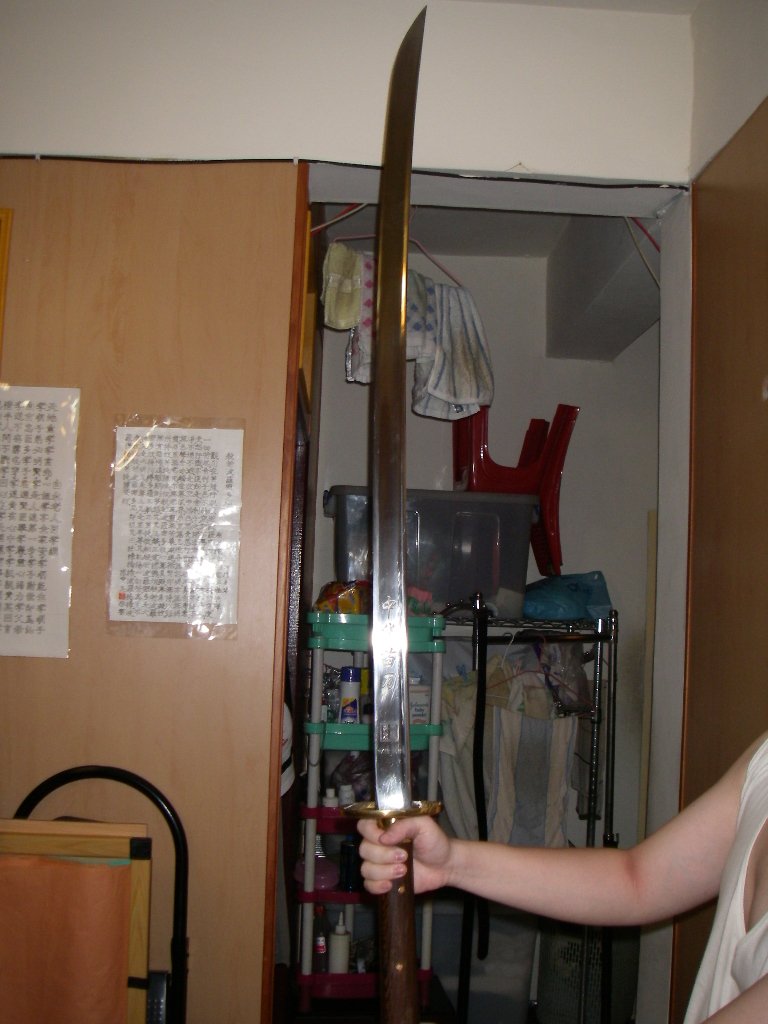Miaodao on:
[Wikipedia]
[Google]
[Amazon]

 The ''miaodao'' (苗刀) is a Chinese two-handed '' dao'' or
The ''miaodao'' (苗刀) is a Chinese two-handed '' dao'' or
File:Wang Zhihai MiaoDao.jpg, Wang Zhihai performing with a ''miaodao''
* Duan Ping (段平), Zheng Shouzhi (郑守志) et al. Wushu Cidian (武术词典) Wushu Dictionary. Renmin Tiyu Chubanshe, 2007. . * Ma Mingda (马明达), Shuo jian cong gao (说剑丛稿), . * Rovere, Dennis with Chow Hon Huen (2008). ''The Xingyi Quan of the Chinese Army: Huang Bo Nien's Xingyi Fist and Weapon Instruction''. Blue Snake Books. . * Tom, Philip (February 2005). "An Introduction to Chinese Single-Edged Hilt Weapons (Dao) and Their Use in the Ming and Qing Dynasties". ''Kung Fu Tai Chi'', p. 85. * Jin Yiming (金一明) (1932), ''Single Defense-Saber'' (單戒刀), New Asia Press, translated by Paul Brennan 201
*Yang Jwing-Ming (楊俊敏) (2023). ''Ancient Chinese Weapons: A Martial Arts Guide''. YMAA Publication Center. .
A comprehensive article about the miaodao
* https://web.archive.org/web/20081103074622/http://www.freewebs.com/jingangbashi/miaodaointro.htm Chinese swords World War II infantry weapons of China Single-edged swords {{Sword-stub
saber
A sabre or saber ( ) is a type of backsword with a curved blade associated with the light cavalry of the Early Modern warfare, early modern and Napoleonic period, Napoleonic periods. Originally associated with Central European cavalry such a ...
, with a narrow blade, long hilt
The hilt (rarely called a haft or shaft) is the handle of a knife, dagger, sword, or bayonet, consisting of a guard, grip, and pommel. The guard may contain a crossguard or quillons. A tassel or sword knot may be attached to the guard or pomme ...
, and an overall length of or longer. The name means "sprout saber", presumably referring to a likeness between the weapon and a newly sprouted plant. An early reference, in Jin Yiming's ''Single Defense-Saber'', makes a connection between the ''miaodao'' and the Qing-era '' wodao'', as well as mentioning both single and two-handed versions of the ''miaodao'', suggesting that the name originally described the shape only, without any connotations of size. While the ''miaodao'' is a recent weapon, the name has come to be applied to a variety of earlier Chinese long sabers, such as the ''zhanmadao
The ''zhanmadao'' () was a single-bladed anti-cavalry Chinese sword. It originated during the Han dynasty (206 BC – 220 AD) and was especially common in Song dynasty, Song China (960–1279).
General characteristics
The ''zhanmadao'' is a ...
'' and ''changdao
The ''changdao'' ( zh, t=長刀, s=长刀, first=t, p=chángdāo, l=long sword) was a two-handed, single-edged Chinese swords, Chinese sword. The term has been translated as "long saber," "saber-staff," or "long-handled saber." During the Ming ...
''. Along with the '' dadao'', ''miaodao'' were used by some Chinese troops during the Second Sino-Japanese War
The Second Sino-Japanese War was fought between the Republic of China (1912–1949), Republic of China and the Empire of Japan between 1937 and 1945, following a period of war localized to Manchuria that started in 1931. It is considered part ...
.
While the ''miaodao'' is rarely practiced in modern Chinese martial arts, some schools of Piguaquan and Tongbeiquan (in the Guo Changsheng lineage) and Xingyiquan
形意拳, Xingyiquan , or Xingyi, is a style of internal Chinese martial arts. The word approximately translates to "Form-Intention Fist", or "Shape-Will Fist".
The style is characterized by aggressive, seemingly linear movements, and expl ...
train with the weapon. The ''miaodao'' is also often mistakenly claimed to have been one of the weapons taught at the Central Military Academy in Nanjing; the weapon in question was actually a European-style officer's saber, though some later schools may have based ''miaodao'' techniques on this form.
Despite being written the same way (苗), the "miao" of ''miaodao'' should not be confused with the Miao ethnic group, who are not associated with this weapon.
Gallery
See also
*Chinese sword
Historically, Chinese swords are classified into two types, the '' jian'' and the '' dao''. A ''Jian'' is a straight, double-edged sword mainly used for stabbing; the term has been commonly translated into the English language as a longsword. M ...
*Dao (Chinese sword)
''Dao'' (pronunciation: , English approximation: , Chinese language, Chinese: 刀; pinyin: ''dāo''; jyutping: ''dou1'') are single-edged Chinese swords, primarily used for slashing and chopping. They can be straight or curved. The most common ...
*Japanese sword
A is one of several types of traditionally made swords from Japan. Bronze swords were made as early as the Yayoi period (1,000 BC – 300 AD), though most people generally refer to the curved blades made from the Heian period (794–1185) to the ...
*Katana
A is a Japanese sword characterized by a curved, single-edged blade with a circular or squared guard and long grip to accommodate two hands. Developed later than the ''tachi'', it was used by samurai in feudal Japan and worn with the edge fa ...
References
* Dekker, Peter (2016), “Chinese long sabers of the Qing dynasty”, Mandarin Mansio* Duan Ping (段平), Zheng Shouzhi (郑守志) et al. Wushu Cidian (武术词典) Wushu Dictionary. Renmin Tiyu Chubanshe, 2007. . * Ma Mingda (马明达), Shuo jian cong gao (说剑丛稿), . * Rovere, Dennis with Chow Hon Huen (2008). ''The Xingyi Quan of the Chinese Army: Huang Bo Nien's Xingyi Fist and Weapon Instruction''. Blue Snake Books. . * Tom, Philip (February 2005). "An Introduction to Chinese Single-Edged Hilt Weapons (Dao) and Their Use in the Ming and Qing Dynasties". ''Kung Fu Tai Chi'', p. 85. * Jin Yiming (金一明) (1932), ''Single Defense-Saber'' (單戒刀), New Asia Press, translated by Paul Brennan 201
*Yang Jwing-Ming (楊俊敏) (2023). ''Ancient Chinese Weapons: A Martial Arts Guide''. YMAA Publication Center. .
External links
A comprehensive article about the miaodao
* https://web.archive.org/web/20081103074622/http://www.freewebs.com/jingangbashi/miaodaointro.htm Chinese swords World War II infantry weapons of China Single-edged swords {{Sword-stub